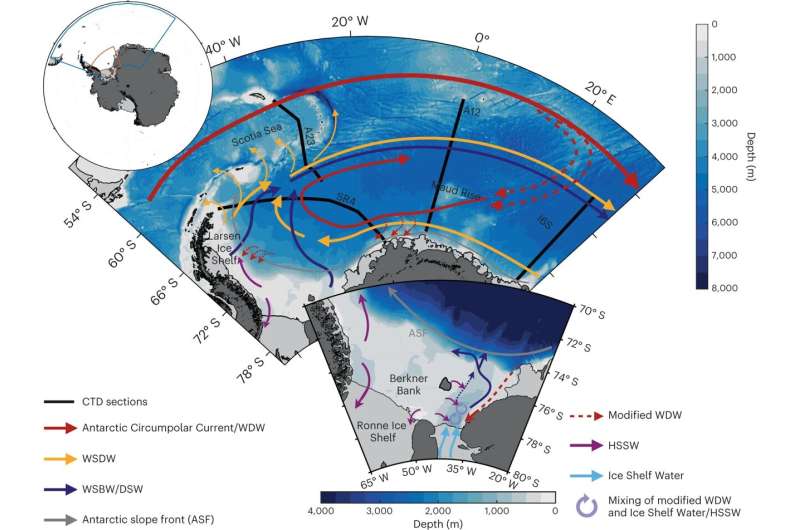This article has been reviewed according to Science X's editorial process and policies. Editors have highlighted the following attributes while ensuring the content's credibility:
fact-checked
peer-reviewed publication
trusted source
proofread
Shrinking and warming of Antarctic deep ocean waters has 'far reaching consequences' for global climate

Deep ocean water in Antarctica is warming and shrinking at an alarming rate with significant consequences for the global climate and the world's oceans, according to new research involving the University of Southampton.
Antarctic Bottom Water is the coldest, densest water mass on the planet, and it plays a crucial role in regulating the ocean's ability to store heat and capture carbon; 90 percent of human-induced global heating and almost a third of the extra carbon released since the start of the industrial revolution has been absorbed by the ocean.
A new study, published today in the journal Nature Climate Change, presents observational evidence from the Weddell Sea in Antarctica showing that these waters have shrunk by 20 percent over the past 30 years, while shallower waters warmed at a rate five times higher than the rest of the global ocean.
The research from the British Antarctic Survey (BAS) and the University of Southampton is the first observational evidence that long-term changes to the winds and sea ice are influencing bottom water production in the Weddell Sea—one of the largest producers of dense bottom water.
Dr. Alessandro Silvano from the University of Southampton, who is a co-author of the study, says, "The shrinking of deep waters in Antarctica can have far reaching consequences, from reducing the ability of the ocean to absorb carbon associated with human activities to decreasing the oxygen supply to abyssal waters, affecting deep ecosystems."
"We used to think that changes in the deep ocean could only occur over centuries. But these key observations from the Weddell Sea show that changes in the dark abyss can take place over just a few decades."
Using decades of ship-based observations, alongside satellite data, the team discovered that these waters have been declining in volume over the past 30 years. The measurements are a result of numerous scientific voyages to the Weddell Sea, measuring the temperature and saltiness of the oceans from the surface to the seabed.
Dr. Povl Abrahamsen, a physical oceanographer at BAS and co-author, says, "As part of our long-term monitoring, we try to investigate these sections every one or two years. Annual or biennial measurements are needed to disentangle short-term changes from the long-term warming trends, and therefore better understand the causes of both. Some of these sections were first visited as far back as 1989, making them some of the most comprehensively sampled regions in the Weddell Sea."
Weakening winds and slowing sea ice formation
The new study discovered that the shrinking bottom waters are a result of a slowing sea ice formation.
Normally, strong winds push newly formed ice away from the shelf, creating open areas for more ice to form. But weakening winds near the Filchner-Ronne ice shelf in the Southern Weddell Sea have reduced the size of these gaps in the sea ice cover, resulting in a slowdown in the formation of new ice.
As new ice forms, it leaves behind salt, contributing to the creation of the cold and salty Antarctic Bottom Water. The shortage of these salty shelf waters has triggered the shrinking of bottom waters.
Links to large-scale atmospheric patterns
The researchers uncovered an interplay between large-scale atmospheric patterns, connecting responses in the tropical Pacific to the Southern Ocean. Changes in these patterns have caused shifts in the winds across the Southern Ocean, resulting in reduced northerly winds across the Weddell Sea, and in turn a reduction in sea ice formation.
The changes are a consequence of natural variability in the system, although potentially stronger changes are predicted in the future.
The findings come as with other recent high-profile findings that show similar reductions in bottom water coming from the Ross Sea , as well as modeled future collapse in bottom waters; both due to the accelerated melting of Antarctic ice shelves.
Dr. Shenjie Zhou, the lead author of the study and physical oceanographer at BAS, says, "These results show just how sensitive this region, specifically the Antarctic abyssal overturning circulation which is a key regulator of global climate, is to the climate changes happening both remotely and locally. It highlights the complex interplay between atmosphere and sea ice which needs to be properly represented in climate models in order for us to confidently predict how it may respond in the future."
More information: Shenjie Zhou et al, Slowdown of Antarctic Bottom Water export driven by climatic wind and sea-ice changes, Nature Climate Change (2023). DOI: 10.1038/s41558-023-01695-4
Journal information: Nature Climate Change
Provided by University of Southampton



















